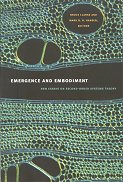Emerging in the 1940s, the first cybernetics—the
study of communication and control systems—was
mainstreamed under the names artificial intelligence and computer science
and taken up by the social sciences, the humanities, and the creative arts.
In Emergence and Embodiment, Bruce Clarke and Mark B. N. Hansen
focus on cybernetic developments that stem from the second-order turn in the 1970s,
when the cyberneticist Heinz von Foerster catalyzed new thinking
about the cognitive implications of self-referential systems.
The crucial shift he inspired was from first-order cybernetics’ attention
to homeostasis as a mode of autonomous self-regulation in mechanical and informatic systems,
to second-order concepts of self-organization and autopoiesis in embodied and metabiotic systems.
The collection opens with an interview with von Foerster
and then traces the lines of neocybernetic thought that have followed from his work,
In response to the apparent dissolution of boundaries at work in the contemporary techno-sciences of emergence, neocybernetics observes that cognitive systems are operationally bounded, semi-autonomous entities coupled with their environments and other systems. Second-order systems theory stresses the recursive complexities of observation, mediation, and communication. Focused on the neocybernetic contributions of von Foerster, Francisco Varela, and Niklas Luhmann, this collection advances theoretical debates about the cultural, philosophical, and literary uses of their ideas.
